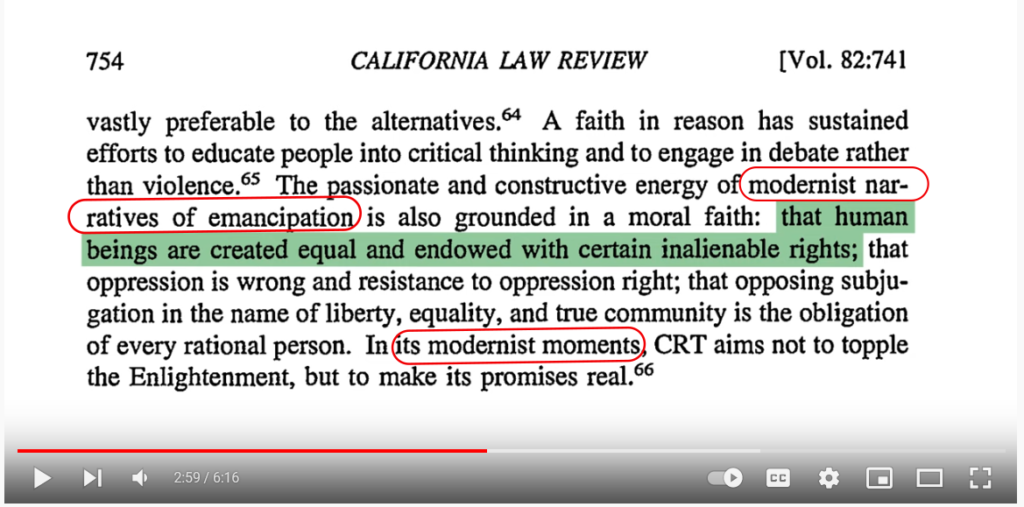PolitiFact's video explainer for critical race theory hides from its audience the movement's postmodernist hostility to Western culture.
We’ve noticed PolitiFact misleading its audience about critical race theory multiple times. But this post will focus on an example from PolitiFact’s video version of its 2021 explainer “What is critical race theory?”
PolitiFact’s Jon Greenberg, at about 2:48, suggests CRT is as American as apple pie, citing a paper by a proponent:
In 1994, a law professor in this field wrote that critical race theory was based on the quintessential American ideal that human beings are created equal and endowed with certain inalienable rights, that oppression is wrong and resistance to oppression, right.
In fact-checking fact checkers we naturally inquire about the context of claims such as Greenberg’s. The text backdrop in the video prompted immediate questions about whether Greenberg took the quotation out of context. What did the author, Angela P. Harris, mean by “modernist narratives of emancipation” and “modernist moments”?
Critical Race Theory’s Internal Tension
Harris’ paper (.pdf here), Foreword: The Jurisprudence of Reconstruction, does not say that CRT is based on quintessential American ideals. The paper says CRT’s “modernist narratives of emancipation” are based on those quintessential American ideals. As for CRT’s narratives of the non-modernist kind, those would apparently topple the Enlightenment. Or so Greenberg’s backdrop appears to suggest (red ellipses added for emphasis).

Greenberg took Harris out of context. Two paragraphs after the one Greenberg showed us, Harris addressed the contradiction between CRT’s modernist and postmodernist moments:
In both its modernist and its postmodernist moments, CRT puts law’s supposed objectivity and neutrality on trial, arguing that what looks like race-neutrality on the surface has a deeper structure that reflects white privilege. But where modernist narratives ultimately place faith in the real existence of subjects, objects, and reason, postmodernist narratives would put each of these concepts in quotes. The narratives of modernism and of postmodernism are at war with one another, not simply in terms of the strategies they use or the conclusions they reach, but also in the way they see the world.
Indeed, Harris earlier made clear that CRT’s postmodern moments may find racism intrinsic to Western culture or even the Enlightenment.
Postmodernist critique is congenial to race-crits, who had already drawn from history the lesson that “racism” is no superficial matter of ignorance, conscious error, or bigotry, but rather lies at the very heart of American-and western-culture. In one of the foundational articles of CRT, Kimberly Crenshaw notes that the civil rights movement achieved material and symbolic gains for blacks, yet left racist ideology and race-baiting politics intact.’ In Crenshaw’s view, the crits’ critiques did not go far enough to expose the racism in legal reasoning and legal institutions. Derrick Bell argues that racism is a permanent feature of the American landscape, not something that we can throw off in a magic moment of emancipation. And in a moment of deep pessimism, Richard Delgado’s fictional friend “Rodrigo Crenshaw” has suggested that racism is an intrinsic feature of “The Enlightenment” itself.
Notably, Harris sees no need to resolve CRT’s contradiction. Her paper suggests it is somehow a strength of the movement.
How did Greenberg miss that in his reading of her paper? Or did he read it and focus on the modernist narrative while purposely hiding the other from his audience?
Imagine how different PolitiFact’s explainer video might have sounded if it had suggested CRT aims to topple Western culture.
PolitiFact’s source offered two contradictory visions of CRT. One finds its base on quintessential American values such as endowment with inalienable rights. The other calls quintessential American values racist to the core. PolitiFact, whether through incompetence or conscious choice, picked one for viewer consumption and hid the other.
PolitiFact’s explainer video could hardly have applied more spin.



